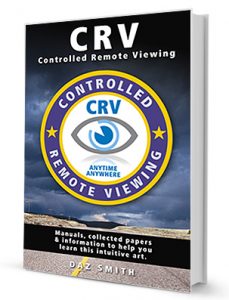Controlled Remote Viewing (CRV)
 During experimentation at SRI from 1972 – 1985, Ingo Swann a SRI sub contractor, began constructing a set of psychic methods which he felt addressed the important aspects of psychic work. The methods centre around an artistic process – writing or sketching data, using strict protocols whilst sitting at a table in a full alert state. The idea behind the method was to create a technology that made (RV) Remote Viewing, teachable to others but to also decrease the ‘noise’ within the RV process from an initial 20% signal – 80% noise. Reports from SRI (1984/85) indicate that the new process managed to reverse the signal to noise problem to 80% signal and 20% noise. This method was called CRV (Controlled remote Viewing) and eventually developed into a set of six stages, each stage building on the previous, opening a wider channel and picture of the target with each stage. The CRV process was paid for and sold into the U.S. Military as their primary Remote Viewing technique.
During experimentation at SRI from 1972 – 1985, Ingo Swann a SRI sub contractor, began constructing a set of psychic methods which he felt addressed the important aspects of psychic work. The methods centre around an artistic process – writing or sketching data, using strict protocols whilst sitting at a table in a full alert state. The idea behind the method was to create a technology that made (RV) Remote Viewing, teachable to others but to also decrease the ‘noise’ within the RV process from an initial 20% signal – 80% noise. Reports from SRI (1984/85) indicate that the new process managed to reverse the signal to noise problem to 80% signal and 20% noise. This method was called CRV (Controlled remote Viewing) and eventually developed into a set of six stages, each stage building on the previous, opening a wider channel and picture of the target with each stage. The CRV process was paid for and sold into the U.S. Military as their primary Remote Viewing technique.
There are currently a number of people teaching a number of alternative versions of the CRV method.
CRV changed over the years since Remote viewing became public in 1995 many different forms of the original CRV methods have appeared and mutated generally with the help of the internet and the need for individuals to have a different product to sell. Some of these variants we now see today are: TRV, Learn RV, SRV, TDS, and others. There are generally individuals from the military and civilians who have some experience with remote viewing methodologies, such as David Morehouse, Ed Dames, and Dr Courtney Brown who basically teach their own mutated/changed versions of Ingo’s CRV.
Within CRV itself there are variations – and ex Military remote viewers Lyn Buchanan, Paul H Smith and David Morehouse – all teach differing versions of the CRV methodology.
Click here for a infographic of the changing remote viewing methods and how they have changed from the Ingo Swann CRV method with each new generation.

